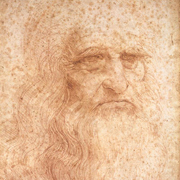[10.10.2012] Paris, Donaueschingen, Vienna: within the space of a few days, three important premieres of works by Beat Furrer take place. A complex choral work, an ensemble work and a chamber music piece for bass flute and double bass.
Enigma
Enigma is the title given by Beat Furrer to a series of five choral compositions after Leonardo da Vinci’s late Profezie. The prophecies of the artist and scholar are a perverse inventory of the visible world looking into a visionary future, to the point of grotesque distortion. Following Enigma I–IV, short pieces partly conceived for youth choir, Beat Furrer now raises the cycle to a new level with Enigma V (Paris 26.10.2012), a complex, extensive composition for double choir. The text is about shadows and reflections. The altered forms, which follow the movements flowing into them, become the starting point for the composition: the principle of the transformation of particles, sticking to each other like form and reflection, is played back and forth between the choral groups, dovetailed into each other in an endless flight. The tiniest melodic shapes are extruded, expanded, reconstructed, piled up into a violent phantom and diffused again. Finally, the regular repetition and the contortion and espressivo are placed in conflict with each other as two principles. “One will see forms and shapes of people and animals, which simply follow these animals and people wherever they flee to; and it will be the movement of the one like the other, but it will appear marvellous to one because of the various shapes into which they transform” (Leonardo da Vinci). The old compositional technique of hocket, of the dovetailing of various voices into a melodic stream, underlies it. In Furrer’s choral composition, a transformation of the language also takes place, for split into syllables, repeated, arranged anew, out of the particles of text new meanings and expressive dimensions result.
linea dell’orizzonte
“What interested me was the phenomenon of doubling, but also of the distortion into a shadow and the creation of the process-related resulting from this intersecting of voices into each other”, says Beat Furrer. In linea dell’orizzonte, his composition for the Ensemble Ascolta (Donaueschingen 21.10.2012), this principle of transformation is applied to a heterogenous group of instruments of piano, violin, cello, clarinet, trumpet, trombone, percussion and electric guitar and realised in a rich, diversified material. Out of the intertwining of the voices emerges a study of distorted shadows.
Ira – Arca
From this formal idea Ira – Arca (Vienna 3.11.2012) for bass flute and double bass was also created, to be premiered in Vienna by Eva Furrer and Uli Fussenegger at the Erste Bank Composition Award: according to Beat Furrer, the title denotes “a formal principle of Inca music. Each melody complements itself hocket-style alternating from parts almost breathing in and out. This becomes the formal principle here. Ira – Arca is a study of form and perhaps even something more.”
Marie Luise Maintz
(from [t]akte 2/2012)



